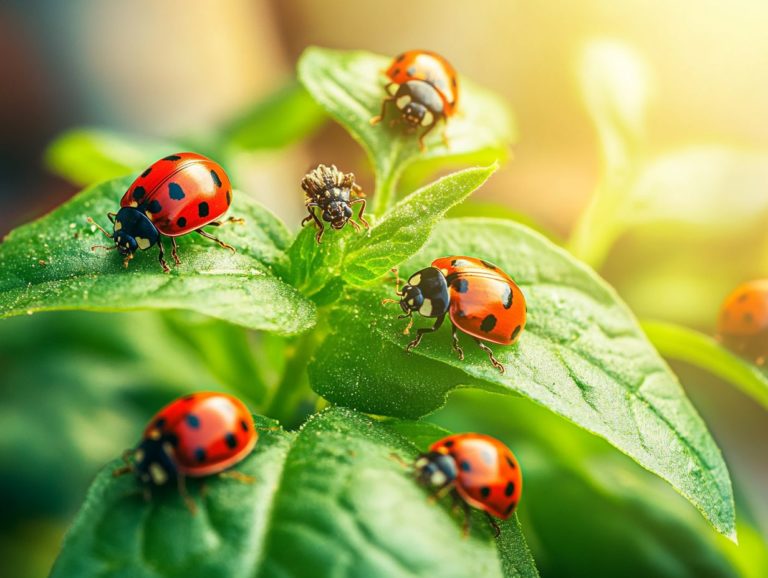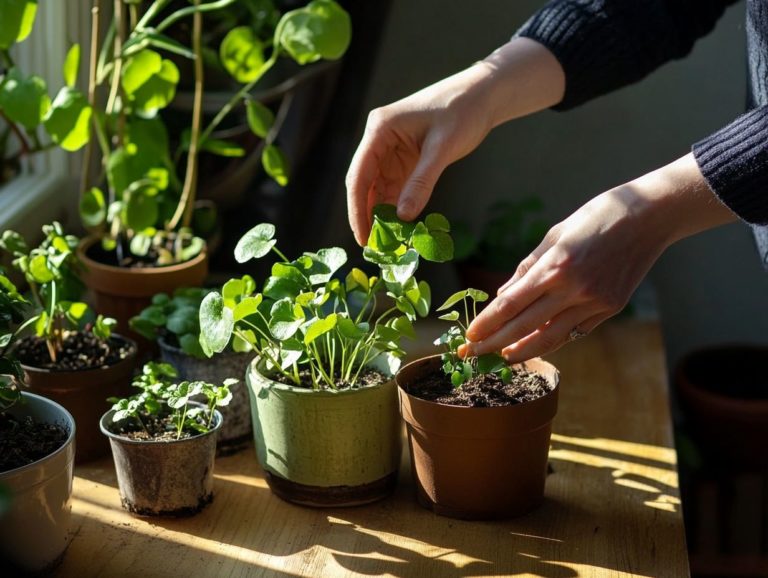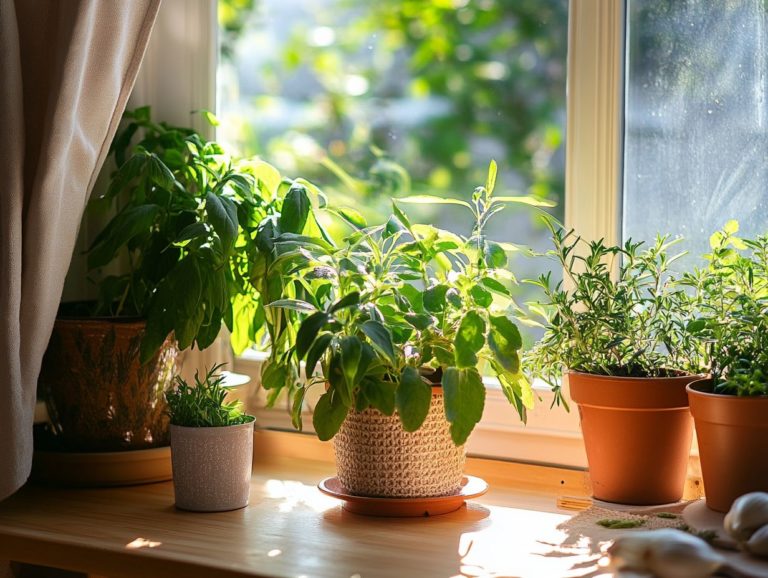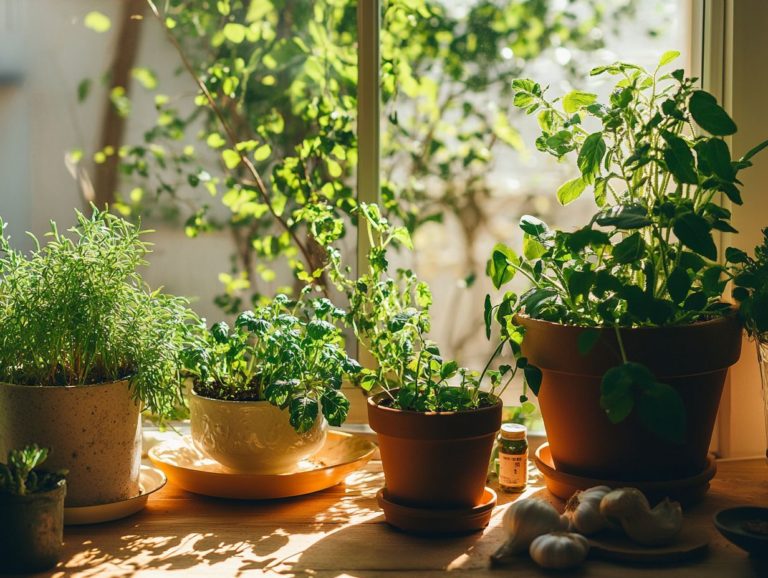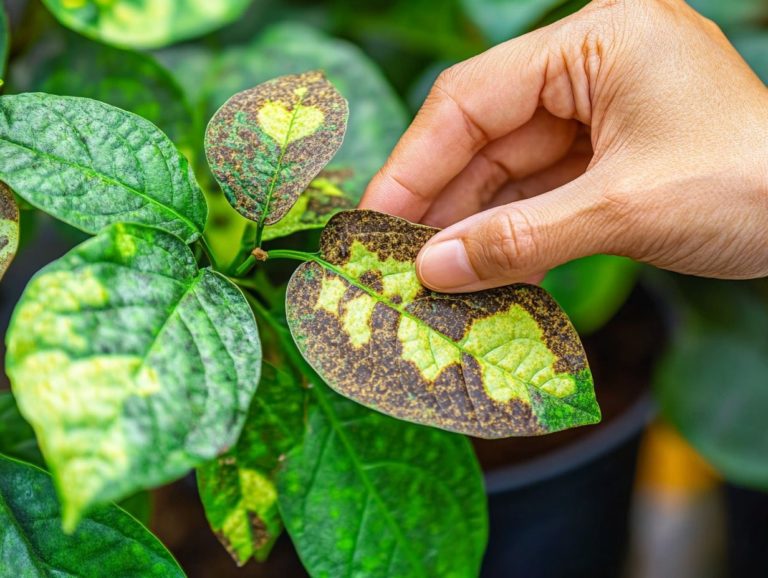How to Use Neem Oil for Indoor Plants
Neem oil has become your secret weapon as an indoor plant enthusiast, offering a natural and effective way to nurture your greenery. Rich in benefits, this oil serves not only as a powerful pest control agent but also boosts your plants’ overall health.
Uncover the advantages of using neem oil, learn how to prepare and apply it correctly, and take note of essential safety precautions to ensure your indoor garden thrives. Moreover, consider exploring alternative pest control methods that may catch your interest. Jump in and transform your plant care routine today!
Contents
- Benefits of Using Neem Oil for Indoor Plants
- Alternatives to Neem Oil
- How to Prepare and Apply Neem Oil
- Precautions and Safety Measures
- Frequently Asked Questions
- How do I use neem oil for indoor plants?
- What are the benefits of using neem oil for indoor plants and plant health?
- Can neem oil be used on all types of indoor plants and outdoor plants?
- How often should I apply neem oil as a preventive measure to my indoor plants?
- Is neem oil safe for pets and children when used correctly?
- Can neem oil be used as a fertilizer for indoor plants or should you use other plant treatments?
Key Takeaways about Using Neem Oil for Indoor Plants:

- Neem oil is a natural and effective way to control pests and improve the health of your indoor plants.
- To prepare and apply neem oil, use a mixture of 1-2 tablespoons of oil per gallon of water and spray it on your plants.
- Remember to use precautions and safety measures when using neem oil, such as wearing protective gear and avoiding direct sunlight on treated plants.
What is Neem Oil and How Does it Work?
Neem oil, derived from the seeds of the neem tree flourishing in tropical forests, stands out as an exceptional organic pesticide. Its active ingredient, azadirachtin, is celebrated for its prowess in pest control; it disrupts insect feeding and growth while remaining relatively gentle on beneficial insects and safe for pets.
This natural remedy not only targets unwelcome pests but also supports environmental care in your gardening pursuits. Azadirachtin, a multi-faceted compound within neem oil, works by interfering with the hormonal processes of pests, effectively stunting their maturation and reproductive capabilities. This makes neem oil a powerful ally for your indoor and outdoor gardening endeavors, enabling you to cultivate robust plants without relying on harsh chemicals typically found in conventional pesticides.
Historically, neem has been a staple in traditional agriculture for centuries, demonstrating its enduring effectiveness. Its ability to break down naturally ensures that it won t linger in the environment, perfectly aligning with sustainable practices that prioritize ecological health and biodiversity.
Benefits of Using Neem Oil for Indoor Plants
Using neem oil as an organic pesticide for your indoor plants brings a wealth of advantages. It provides effective natural pest control against common nuisances like aphids and spider mites. It also enhances the overall health of your plants by preventing fungal diseases like powdery mildew.
This versatility makes neem oil a cherished choice among houseplant enthusiasts and gardening experts alike, such as Kim Toscano.
Natural Pest Control
Natural pest control using neem oil stands as a highly effective strategy, enabling you to combat insect pests without relying on harmful chemicals. This method protects the environment while keeping your plants safe. This solution is especially useful for tackling common issues you might face, such as aphids, which can swiftly weaken your plants; spider mites that thrive in dry conditions; and mealybugs that love to hide in crevices.
By employing neem oil, you can efficiently manage these infestations while also embracing sustainable living practices. The natural compounds within the oil disrupt the life cycles of these pests, gradually reducing their populations and minimizing your environmental footprint.
Many gardening enthusiasts advocate for this method, viewing it as a harmonious balance between effective pest management and ecological responsibility. Ultimately, this choice promotes a healthier garden ecosystem, allowing you to cultivate your space with confidence and care.
Alternatives to Neem Oil
While neem oil is a powerful ally in pest control, considering alternatives can expand your gardening toolkit. Other natural methods, like horticultural soap and vegetable oil, also offer effective solutions and align seamlessly with your commitment to sustainable living.
Improving Plant Health

Improving plant health is a fantastic benefit of using neem oil. It fights common fungal diseases like powdery mildew and boosts the vitality of your plants with its gentle yet effective properties as a plant oil.
This natural remedy acts as a strong fungus-fighting ingredient, providing robust protection against harmful pathogens. Experts agree: using neem oil can change your gardening game! It helps fend off diseases and fortifies your plants’ resilience.
Case studies reveal that consistent application of neem oil has led to remarkable improvements in both crop yield and plant health. Gardeners rave about how easily it integrates into their practices, sharing testimonials of their gardens’ stunning transformations, complete with lush foliage and vibrant blooms thanks to this extraordinary oil.
How to Prepare and Apply Neem Oil
Preparing and applying neem oil correctly is essential to unlocking its full potential as a pest control solution. You should carefully consider the mixing ratios and application methods to decide whether to use diluted neem oil (a mixture of neem oil and water) or a concentrated formula based on your plants’ unique needs.
This thoughtful approach ensures you get the most out of this powerful natural remedy, highlighting the role of active ingredients in its effectiveness.
Mixing Ratios and Application Methods
For mixing ratios, a common suggestion is to combine two tablespoons of diluted neem oil with a quart of water. You might also add horticultural soap to boost the solution’s effectiveness against pests or to enhance plant health.
To achieve the best results, it’s crucial to mix these ingredients thoroughly. This creates a uniform solution that can be effectively applied to both foliage and soil. If you’re dealing with a stubborn pest infestation or specific plants, feel free to adjust the ratios to meet your needs.
In addition to the standard spray technique, consider soil drenches as a viable method. This allows the solution to penetrate directly into the root zone, promoting systemic benefits throughout the plant. By selecting the right application method, you can amplify the advantages of neem oil, fostering healthier plants while reducing the presence of unwelcome pests.
Precautions and Safety Measures
Taking precautions and following safety measures when using neem oil is crucial for protecting yourself and the environment. Especially in commercial applications, apply it according to established guidelines to ensure it remains safe for pets and beneficial insects.
Protecting Yourself and Your Plants

Protecting yourself and your plants while using neem oil involves straightforward yet effective strategies. Start by ensuring proper ventilation during application and choose formulations that are safe for pets, reflecting your commitment to environmental stewardship.
Wearing gloves and masks is essential; it significantly reduces your exposure, allowing you to harness the beneficial properties of neem oil without jeopardizing your safety. Timing is equally important; applying neem oil in the early morning or late evening minimizes the risk of leaf burn while enhancing its effectiveness against pests.
By following these best practices, you cultivate a healthier gardening environment especially for indoor gardening and maximize the natural bioactivity of the oil. This ultimately leads to improved plant health and resilience.
Start using neem oil today and watch your plants thrive!
Other Natural Pest Control Methods
Consider exploring natural pest control methods, such as horticultural soap and vegetable oil. These organic options help manage pests and protect beneficial insects.
These methods are effective against a range of common garden pests, including aphids, spider mites, and whiteflies. Horticultural soaps work by suffocating soft-bodied insects, making them a powerful ally in your pest management toolkit.
Meanwhile, vegetable oils can disrupt pest life cycles, effectively hindering their reproduction.
When weighing these options against neem oil, it s essential to recognize that neem oil boasts a wider range of effects, deterring pests like leafhoppers and caterpillars. However, the methods mentioned earlier are often safer for pollinators.
Integrating these practices into your integrated pest management strategy is vital. This holistic approach combines various methods to control pests effectively and sustainably, minimizing chemical inputs while fostering ecological balance by considering the impact of each method on both pests and beneficial organisms.
Frequently Asked Questions
How do I use neem oil for indoor plants?

To use neem oil for indoor plants, mix 1-2 tablespoons of neem oil with 1 quart of warm water. Use this mixture to water your plants once a week. Alternatively, you can spray the neem oil mixture directly onto the leaves of your plants as a natural insecticide.
What are the benefits of using neem oil for indoor plants and plant health?
Neem oil has many benefits for indoor plants! It serves as a natural and safe insecticide, fungicide, and miticide. It can also help improve the overall health and growth of your plants, as well as protect them from common pests and diseases.
Can neem oil be used on all types of indoor plants and outdoor plants?
Yes, neem oil can be used on all types of indoor plants! It is safe to use on all plant species, including edible plants. Just be sure to follow the recommended dilution ratio and application guidelines for each specific plant.
How often should I apply neem oil as a preventive measure to my indoor plants?
Apply neem oil weekly to keep pests at bay! If you spot any issues, increase your application to every 2-3 days for quick action until the issue is resolved. Always follow the instructions on the neem oil product label.
Is neem oil safe for pets and children when used correctly?
Neem oil is generally safe for pets and children when used according to the recommended dilution ratio and application guidelines. However, it is always best to keep pets and children away from treated plants until the neem oil has dried completely.
Can neem oil be used as a fertilizer for indoor plants or should you use other plant treatments?
No, neem oil should not be used as a fertilizer for indoor plants. Its main purpose is to control pests and diseases. If you are looking for a natural fertilizer for your indoor plants, consider using compost, seaweed extract, or fish emulsion.

